-
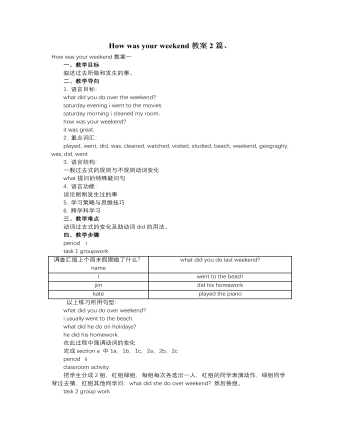
人教版新目标初中英语七年级下册How was your weekend教案2篇
Teaching Goal:1. General aims:Talk about recent past events2. Particular aims:A. Language Focus.Talk about recent past events and think of the past events.B. Language goalsHow was….?It was …What did …do over the weekend?C. Language structures:(1). How was your weekend? I was great. Pay attention to no form.(2). What did you do over the weekend? I played soccer. We went to the beach.D. Useful words and phrases:Words: was, did, went, beach, over, project, test, wasn’t, false, number, geography, spend, week, most, mixture, their, had, little, cook, read, saw, change, everyone, sit, sat, no, anythingPhrases: did one’s homework, played soccer, cleaned my room, went to the beach, played tennis, went to the movies, on Saturday morning, over the weekend, cook … for, what about, do some reading, have a party, talk show, go shoppingE. Grammar language:Present simple past tenseRegular and irregular verbsF. Learning strategies:Tour and holidaysG. Interdiscipinary:H. Emotion and manner:Teaching time: 5 periodsTeaching procedures:Period One教学步骤、时间 教师活动 学生活动 媒体应用Step 1Free talk 3’ Ask some questions like:Who’s on duty today?What’s the weather like? Answer and talk about something.让同学们回答下列问题1. Do you like weekend? (Let some students answer)It takes them three minutes to talk about the question.2. Why do you like weekend? (let the students answer) Most of the students like the weekend此时教师用汉语问:“在周末期间问你干了什么?这句话用英语这么回答?Let the students guess.At last the teacher give them right answer3. What did you do over the weekend?(板书、学习)
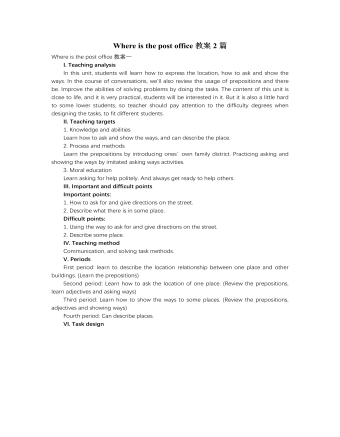
人教版新目标初中英语七年级下册Where is the post office教案2篇
Period 2 (3a----Section B 2c)Preview(Pre-task): Key points: What laAdd another information about their pen pals----their language on the cardnguage does she/he speak?She/He speaks....Does she/he have any brothers and sisters? Does she/he speak English?Preview(Pre-task): Add another information about their pen pals----their language on the cardKey points: What language does she/he speak?She/He speaks....Does she/he have any brothers and sisters? Does she/he speak English?Step 1 Revision1.Revisionand dictation of the new words 2.Revise the drills they learned yesterday.(by pairwork and grammar exercise)Step 2 Leading-inT has a conversation with one student. The conversation is following:---Do you have a pen pal?---Yes, I do.---What's your pen pal's name? ---His/Her name is....---Where is your pen pal from? ---He/She is from...---Where does he/she live? ---He/She lives in....---What language does he/she speak?He/She speaks...Write the new words on the Bb. They are following: EnglishChineseJapaneseFrenchStep 3 LearnLearn the new words with the whole class.Finish 3a with the students3b Pairwork T still does an example with one student Then the Ss practise in pairs. The example is following:--Curry Muray is my pen pal. He is from the United States.---What language does he speak?
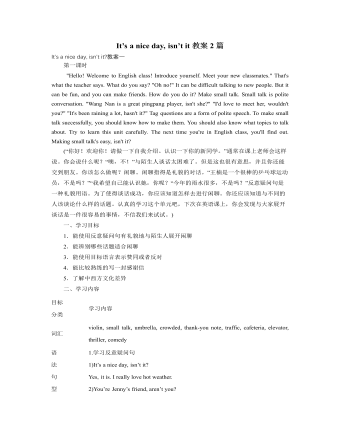
人教版新目标初中英语八年级下册It’s a nice day, isn’t it教案2篇
"Hello! Welcome to English class! Introduce yourself. Meet your new classmates." That's what the teacher says. What do you say? "Oh no!" It can be difficult talking to new people. But it can be fun, and you can make friends. How do you do it? Make small talk. Small talk is polite conversation. "Wang Nan is a great pingpang player, isn't she?" "I'd love to meet her, wouldn't you?" "It's been raining a lot, hasn't it?" Tag questions are a form of polite speech. To make small talk successfully, you should know how to make them. You should also know what topics to talk about. Try to learn this unit carefully. The next time you're in English class, you'll find out. Making small talk's easy, isn't it? (“你好!欢迎你!请做一下自我介绍。认识一下你的新同学。”通常在课上老师会这样说。你会说什么呢?“噢,不!”与陌生人谈话太困难了。但是这也很有意思,并且你还能交到朋友。你该怎么做呢?闲聊。闲聊指得是礼貌的对话。“王楠是一个很棒的乒乓球运动员,不是吗?”“我希望自己能认识她,你呢?“今年的雨水很多,不是吗?”反意疑问句是一种礼貌用语。为了使得谈话成功,你应该知道怎样去进行闲聊。你还应该知道与不同的人该谈论什么样的话题。认真的学习这个单元吧,下次在英语课上,你会发现与大家展开谈话是一件很容易的事情,不信我们来试试。)
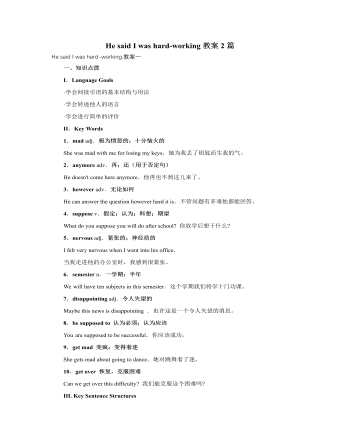
人教版新目标初中英语八年级下册He said I was hard-working教案2篇
This activity introduces some new vocabulary and provide oral practice using the target language.Task 1 . Ask four students to stand in front of the class, and the teacher asks them the following questions as a reporter.1.What are you going to do when you grow up?2.What are you going to do next week?3.What are going to do after school?The students will give different answers, then ask a good student to report what they said.I am going to e a doctor.What did she say?----------She said she was going to be a doctor.I am going to have a party on Friday night.What did he say?-------He said he was going to have a party on Friday night.I am going to do my homework.What did she say ?------ She said she was going to do her homework.I am going home after school.What did she say?-----She said she was going home after school.Say In this unit we are going to learn to use words like to report what someone said.Task 2. Read the instructions. Then ask a student to read the four questions. And write the words on the Bb. Explain what soap opera is.Task 3. Ask the students to Look at the pictures, point out the TV screens in the picture. Ask one girl to read what Marcia said.What did Marcia say? She said She said she was having a surprise party for Lana on Friday night. Repeat the other pictures in the same way.Activity3. Listen and number the pictures in activity 1a.
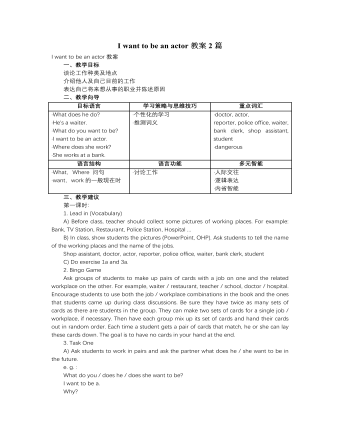
人教版新目标初中英语七年级下册I want to be an actor教案2篇
三、教学建议第一课时:1. Lead in (Vocabulary)A) Before class, teacher should collect some pictures of working places. For example: Bank, TV Station, Restaurant, Police Station, Hospital ...B) In class, show students the pictures (PowerPoint, OHP). Ask students to tell the name of the working places and the name of the jobs.Shop assistant, doctor, actor, reporter, police office, waiter, bank clerk, studentC) Do exercise 1a and 3a.2. Bingo GameAsk groups of students to make up pairs of cards with a job on one and the related workplace on the other. For example, waiter / restaurant, teacher / school, doctor / hospital. Encourage students to use both the job / workplace combinations in the book and the ones that students came up during class discussions. Be sure they have twice as many sets of cards as there are students in the group. They can make two sets of cards for a single job / workplace, if necessary. Then have each group mix up its set of cards and hand their cards out in random order. Each time a student gets a pair of cards that match, he or she can lay these cards down. The goal is to have no cards in your hand at the end.3. Task OneA) Ask students to work in pairs and ask the partner what does he / she want to be in the future.e. g. :What do you / does he / does she want to be?I want to be a.Why?Because it's (adj).B) Vocabulary: Section B, 1a4. Homework 1.2.
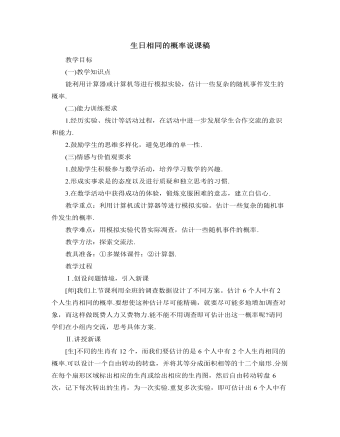
北师大版初中数学九年级上册生日相同的概率说课稿
Ⅵ.活动与探究某种“15选5”的彩票的获奖号码是从1~15这15个数字小选择5个数字(可以重复),若彩民所选择的5个数字恰与获奖号码相同,即可获得特等奖.小明观察了最近100期获奖号码,发现其中竟有51期有重号(同一期获奖号码有2个或2个以上的数字相同),66期有连号(同一期获奖号码中有2个或2个以上的数字相邻).他认为获奖号码不应该有这么多重号和连号,获奖号码可能不是随机产生的,有失公允.小明的观点有道理吗?重号的概率大约是多少?利用计算器模拟实验可以估计重号的概率.[过程]两人组成一个小组,利用计算器产生1~15之间的随机数.并记录下来,每产生5个随机数为一次实验,每组做10次实验,看看有几次重号和连号.将全班的数据汇总集中起来,就可估计出1~15之间的整数中随机抽出5个数出现重号和连号的概率.

北师大版初中数学九年级上册测量旗杆的高度说课稿
在解决问题的过程中,学生使用到了生活中常见的工具——标杆、镜子等,这些小工具摇身一变就成了学生学习用的学具。使学生感觉到利用身边的工具完全可以达到解决问题的目的。八、本节得失本节课意在更好地让学生在实际操作中掌握相似三角形的判定与性质。这节课我感觉成功之处在于:1、立足于问题情境的创设。在课堂教学中创设良好的学习情境,充分激发学生求学热情。当学生的学习投入到教师创设的学习情境中,就会形成主动寻求知识的内在动力。学生在这种学习情境中主动学习到知识,比讲授给他们的要丰富得多,而且更能激发他们的学习兴趣。2、注意培养学生的问题意识。问题解决后,教师应让学生从解决的问题出发,通过对题目的拓展,引导学生用新的思维去再次解决新问题,这样不仅让学生掌握了更多的知识,还能让学生的思维得到升华。3、培养学生自主探索、合作交流的学习方法和习惯。
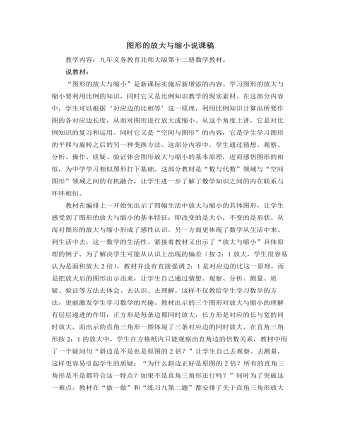
北师大版初中数学九年级上册图形的放大与缩小说课稿
说教学难点:图形的放大与缩小的原理是“大小改变,形状不变“。针对小学生的年龄和认知特点,教材中“图形的放大与缩小”从对应边的比相等来进行安排,而对应角的不变也是形状不变必备的条件,是学生体会图形的相似所必需的。学生在学习的过程中很有可能会质疑到这一问题。(为什么直角三角形只需要同时把两条直角边放大与缩小?)所以我把“学生在观察、比较、思考和交流等活动中,感受图形放大、缩小,初步体会图形的相似。(对应边的比相等,对应角不变)”做为本节课的难点。说教法、学法:通过直观演示,情景激趣,结合生活让学生形成感性认识;引导学生经过观察、猜想、分析、操作、质疑、小组交流、合作学习、验证等过程形成理性认识。教学过程:(略)

北师大版初中数学九年级上册反比例函数的图象与性质说课稿
问题6:观察刚才所画的图象我们发现反比例函数的图象有两个分支,那么它的分布情况又是怎么样的呢?在这一环节中的设计:(1) 引导学生对比正比例函数图象的分布,启发他们主动探索反比例函数的分布情况,给学生充分考虑的时间;(2) 充分运用多媒体的优势进行教学,使用函数图象的课件试着任意输入几个k的值,观察函数图象的不同分布,观察函数图象的动态演变过程。把不同的函数图象集中到一个屏幕中,便于学生对比和探究。学生通过观察及对比,对反比例函数图象的分布与k的关系有一个直观的了解;(3) 组织小组讨论来归纳出反比例函数的一条性质:当k>0时,函数图象的两支分别在第一、三象限内;当k<0时,函数图象的两支分别在第二、四象限内。
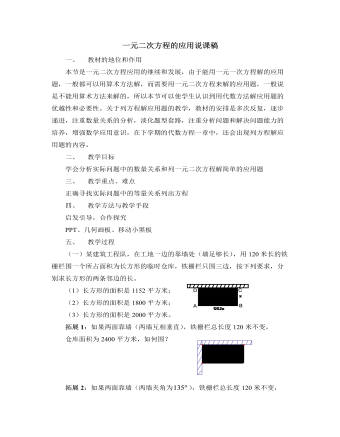
北师大版初中数学九年级上册一元二次方程的应用说课稿
(三)如图, 中, ,AB=6厘米,BC=8厘米,点 从点 开始,在 边上以1厘米/秒的速度向 移动,点 从点 开始,在 边上以2厘米/秒的速度向点 移动.如果点 , 分别从点 , 同时出发,经几秒钟,使 的面积等于 ?拓展:如果把BC边的长度改为7cm,对本题的结果有何影响?(四)本课小结列方程解应用题的一般步骤:1、 审题:分析相关的量2、 设元:把相关的量符号化,设定一个量为X,并用含X的代数式表示相关的量3、 列方程:把量的关系等式化4、 解方程5、 检验并作答(五)布置作业1、请欣赏一道借用苏轼诗词《念奴娇·赤壁怀古》的头两句改编而成的方程应用题, 解读诗词(通过列方程,算出周瑜去世时的年龄)大江东去浪淘尽,千古风流数人物,而立之年督东吴,早逝英年两位数,十位恰小个位三,个位平方与寿符,哪位学子算得快,多少年华属周瑜?本题强调对古文化诗词的阅读理解,贯通数学的实际应用。有两种解题思路:枚举法和方程法。
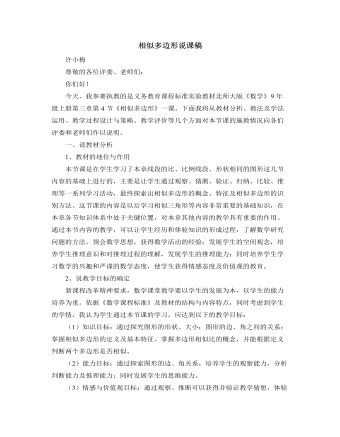
北师大版初中数学九年级上册相似多边形说课稿
五、说课件设计及板书随着教育现代化的发展,多媒体课件在课堂中辅助教师授课,帮助学生练习,已成为非常重要的教学辅助工具之一。在本节课的授课过程中,本人也使用了多媒体教学课件。课件在设计上遵循实用性原则、辅助性原则、创新性原则,紧紧围绕教学目标,服务于课堂教学,设计科学合理,制作精美细致;课件的有效使用很好地优化了课堂,极大地扩充了容量,有力地突出了重点,轻松地化解了难点;使学生学习兴趣浓郁,使教学效率大大提高;特别是在演示多边形对应角相等的设计,使这一教学环节变得更直观、更高效、更方便,让学生轻松地进行探究,很好地保护了学生的学习热情,方便了教师的策略实现。在授课过程中,我又不是完全依赖于多媒体课件,而成了课件反映员;我充分发挥教师的主导作用,合理地利用黑板板书有关内容,灵活动配合多媒体课件为学生呈现有关知识点,以弥补课件的不足。

北师大版初中数学九年级上册平行线分线段成比例说课稿
三、达标测试这一环节,我共设计了5道题,题型有选择、填空、解答。这些题都来自于课后习题,是课后习题的重组和整合,能够很好地考查学生对本节课的掌握情况。这一环节设计以多变的题型呈现,总体还是以基础题为主,以课后习题为主要内容设计,可把课后习题改编成填空、选择、计算、解答、证明等。这些题的设计要有典性、代表性,要紧跟时代步伐。80%-90%的学生能做全对,题量不能超过6道题。学生答题时间不能超过8分钟。四、拓展延伸这一环节以综合运用推论的一道计算题呈现的。旨在让学生在课后巩固对推论的理解,另一方面也为后面学习相似三角形做铺垫。以上几个环节环环相扣,层层深入,并充分体现教师与学生的交流互动,在教师的整体调控下,学生通过动脑思考、层层递进,对知识的理解逐步深入,使课堂效益达到最佳状态。
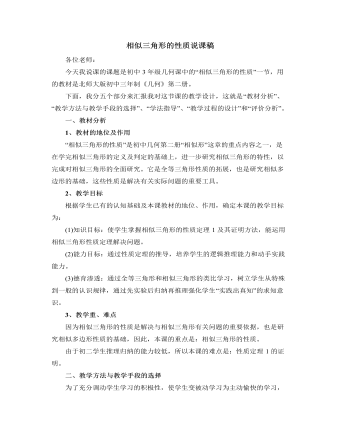
北师大版初中数学九年级上册相似三角形的性质说课稿
接着,引导学生回答命题1的题设、结论,教师把命题1的图示画在黑板上,得到以下的数学表达式。已知:如图,△ABC∽△A/B/C/、△ABC与△A/B/C/的相似比是K,AD、A/D/是对应高。求证:AD/A/D/=K首先让学生回忆,证明线段成比例学过哪些方法,接着引导学生分析证明思路:要证AD/A/D/=K,根据图形学生能找到含对应高和对应边的两对三角形,即△ADB和△A/D/B/、△ADC和△A/D/C/。若要证AD/A/D/=K,则应有△ADB∽△A/D/B/,由条件可知∠ADB=∠A/D/B/=90°,∠B=∠B/,于是可得△ADB∽△A/D/B/,得到AD/A/D/=K。随后,学生口述教师板书规范的证明过程。接着问学生还有哪些证明方法?同理可证得其他两边上的对应高的比等于相似比,所以命题1具有一般性。而对于命题2、命题3的数学表达式和证明方法与命题1类似,所以为了提高教学效率,用投影依次将命题2、命题3的已知、求证和题图显示出来,并指导学生课堂练习证明这两个命题。
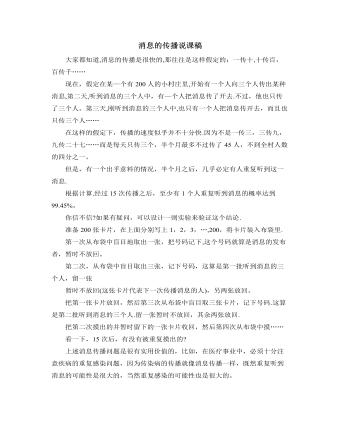
北师大版初中数学九年级上册消息的传播说课稿
准备200张卡片,在上面分别写上1,2,3,…,200,将卡片装入布袋里.第一次从布袋中盲目地取出一张,把号码记下,这个号码就算是消息的发布者,暂时不放回。第二次,从布袋中盲目取出三张,记下号码,这算是第一批听到消息的三个人,留一张暂时不放回(这张卡片代表下一次传播消息的人),另两张放回。把第一张卡片放回,然后第三次从布袋中盲目取三张卡片,记下号码.这算是第二批听到消息的三个人.留一张暂时不放回,其余两张放回.把第二次摸出的并暂时留下的一张卡片收回,然后第四次从布袋中摸……看一下,15次后,有没有被重复摸出的?上述消息传播问题是很有实用价值的,比如,在医疗事业中,必须十分注意疾病的重复感染问题,因为传染病的传播就像消息传播一样,既然重复听到消息的可能性是很大的,当然重复感染的可能性也是很大的。
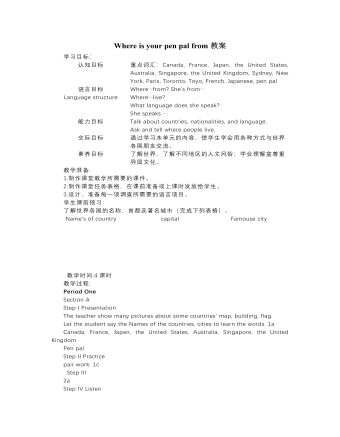
人教版新目标初中英语七年级下册Where is your pen pal from教案
2.1Match the country with the language.Step II Reading3a? let the students read the letter fast and answer the questions.? Let the students ask more questions about the letter as possible as the can.Step III Writing3b.Step IV. Pairwork2cStep V Listening2a, 2bStep V. HomeworkExercises book(1) P3Exercises book (2) P3Period FourStep I . Dictate the words and sentences in Unit1.Step II. Self-checkStep III. Check the answers for Exercises book in the unit.Step IV. Home workRevise and preparation for unit 2.教学反思:通过本单元的学习,学生基本可以谈论人们的国籍,居住城市及其所说的语言,通过书信方式去介绍自己并寻找笔友。但在涉及到国外的一些城市时,学生对这方面的知识相对欠缺,能介绍的城市并不多,也反应出学生课前预习不充分,这跟学生学习条件也有关,大多数学生无法通过网络获取所需信息。因此,在以后的教学中要多指导学生通过计算机网络获取信息,拓宽知识面。
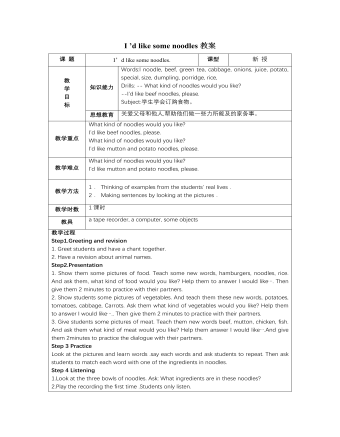
人教版新目标初中英语七年级下册I ’d like some noodles教案
教学过程Step 1: warming-up Sing a song---------“food and drink” Step 2: Revision1 Dictation2 Revise: What kind of noodles would you like?I’d like …What size bowl of noodles would you like?I’d like…Step 3: Presentation1 show pictures of food, ask students say the words.2 Students read the newspaper ad in 3a. Fill in blanks with words in the box. Then read the ad together, the teacher explains some difficult language points.3 Check the answers Step 4 PracticeAsk students to finish 3b in the same way according to 3a. Students read the short passage and fill in the blanks .At last, check the answers.Step 5 productionAsk students to write their own ad for dumplings, noodles, drinks, and other foods they know. Then ask students to read their partner’s ad. Then order food and drink from their partner.Step 6 Home workGroup work – make an ad about “food and drink”
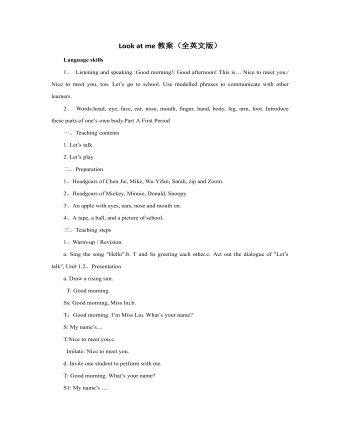
人教版新课标PEP小学英语三年级上册Look at me教案(全英文版)
3、Practicea. Nice to meet you. Nice to meet you,too.b. Perform the dialogue.c. Arrange the dialogue according to the pictures or sentence cards.d. Let’s play.A: Good afternoon,B. This is C. Hello, C! Nice to meet you.C: Nice to meet you, too.A,B: Goodbye!C: Bye!4、Assessment Workbook page 10Add-activitiesa. Listen to the recording and repeat.b. Make a dialogue according to "Let’s talk".Second Period一、Teaching contents1. Let’s learn Words:body, leg, arm, hand, finger, foot.1. Let’s do二、Preparation1、a puppet2、Cards of body, leg, arm, hand, finger and foot.3、headgear of a captain三、Teaching steps1、Warm-up/ Revisiona. Captain says to review "let’s do" of Part A.b. Perform the students their own dialogues.2、Presentationa. Learn to say "body, leg, arm, hand, finger and foot."b. Listen to the recording and repeat.c. Let’s do. Clap your hands. Snap your fingers. Wave your arms. Cross your legs. Shake your body. Stamp your foot.3、Practicea. Let’s draw a person.b. Let’s do. Point out which picture.c. Let’s do. Who responses faster.4、Assessment Workbook page 115、Add-activitiesa. Listen to the recording, repeat and act out.b. Say all the names of the body to your parents.Third Period一、Teaching contents1. Let’s check2. Let’s chant二、Preparation1、stationeries1、pictures of parts of Zoom
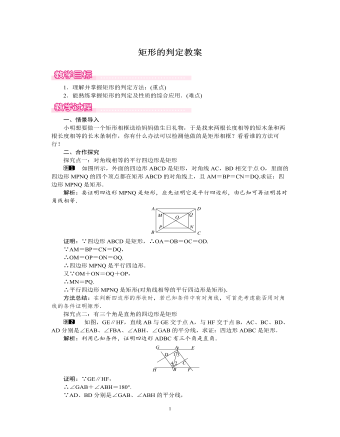
北师大初中数学九年级上册矩形的判定1教案
在△AEF和△DEC中,∠AFE=∠DCE,∠AEF=∠DEC,AE=DE,∴△AEF≌△DEC(AAS),∴AF=DC.∵AF=BD,∴BD=DC;(2)当△ABC满足AB=AC时,四边形AFBD是矩形.理由如下:∵AF∥BD,AF=BD,∴四边形AFBD是平行四边形.∴AB=AC,BD=DC,∴∠ADB=90°.∴四边形AFBD是矩形.方法总结:本题综合考查了矩形和全等三角形的判定方法,明确有一个角是直角的平行四边形是矩形是解本题的关键.三、板书设计矩形的判定对角线相等的平行四边形是矩形三个角是直角的四边形是矩形有一个角是直角的平行四边形是矩形(定义)通过探索与交流,得出矩形的判定定理,使学生亲身经历知识的发生过程,并会运用定理解决相关问题.通过开放式命题,尝试从不同角度寻求解决问题的方法.通过动手实践、合作探索、小组交流,培养学生的逻辑推理能力.
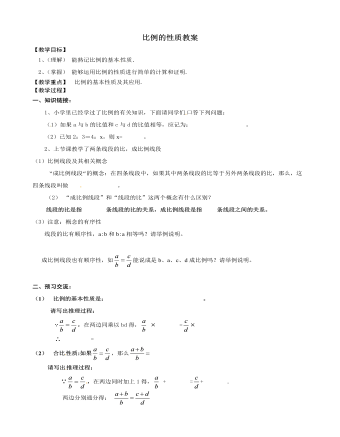
北师大初中数学九年级上册比例的性质2教案
请写出 推理过程:∵ ,在两边同时加上1得, + = + .两边分别通分得: 思考:请仿照上面的方法,证明“如果 ,那么 ”.(3) 等比性质:猜想 ( ),与 相等吗?能 否证明你的猜想?(引导学生从上述实例中找出证明方法)等比性质:如果 ( ),那么 = .思考:等比性质中,为什么要 这个条件?三、 巩固练习:1.在相同时刻的物高与影长成比例,如果一建筑在地面上影长为50米,高为1.5米的测竿的影长为2.5米 ,那么,该建筑的高是多少米?2.若 则 3.若 ,则 四、 本课小结:1.比例的基本性质:a:b=c:d ;2. 合比性质:如果 ,那么 ;3. 等比性质:如果 ( ),五、 布置作业:课本习题4.2

北师大初中数学九年级上册反比例函数1教案
解:(1)根据题意,可得y=100025x,化简得y=40x;(2)根据题设可知自变量x的取值范围为0<x<85.方法总结:反比例函数的自变量取值范围是全体非零实数,但在解决实际问题的过程中,自变量的取值范围要根据实际情况来确定.解题过程中应该注意对题意的正确理解.三、板书设计反比例函数概念:一般地,如果两个变量x,y之间 的对应关系可以表示成y=kx(k 为常数,k≠0)的形式,那么称y 是x的反比例函数,反比例函数 的自变量x不能为0确定表达式:待定系数法建立反比例函数的模型结合实例引导学生了解所讨论的函数的表达形式,形成反比例函数概念的具体形象,从感性认识到理性认识的转化过程,发展学生的思维.利用多媒体创设大量生活情境,让学生体验数学来源于生活实际,并为生活实际服务,让学生感受数学有用,从而培养学生学习数学的兴趣.





















